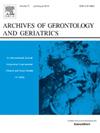亚甲基四氢叶酸还原酶(MTHFR)的常见多态性:与意大利北部老年受试者血浆同型半胱氨酸浓度和认知状态的关系
IF 3.5
3区 医学
Q2 GERIATRICS & GERONTOLOGY
引用次数: 0
摘要
高同型半胱氨酸血症可能是认知障碍的危险因素。亚甲基四氢叶酸还原酶(MTHFR)是同型半胱氨酸(Hcy)代谢的关键酶。MTHFR 677C- >T和1298A- >C多态性都与轻度高同型半胱氨酸血症有关,特别是在低叶酸状态下。在194名意大利老年人中评估了这些MTHFR多态性的患病率及其与血浆总Hcy (tHcy),血清叶酸和认知功能的关系:122名健康对照(73.8 +/- 7.1岁),24名认知受损-非痴呆个体(78.6 +/- 9.3岁),48名阿尔茨海默氏痴呆(AD = 26),血管性痴呆(VD =22;85.5 +/- 7.0年)。21%的受试者为677C- >T纯合子,7%为1298A- >C多态性纯合子。mthfr多态性与年龄、认知状况和痴呆类型无显著关系。血浆tHcy在MTHFR基因型之间没有显著差异,但所有基因型的受试者血清叶酸水平均较低(= 12 nmol /l)。该研究表明,677C- >T和1298A- >C多态性在意大利北部人群中很常见,但即使在低叶酸状态下,也不会显著影响老年人血浆tHcy水平。缺乏年龄和认知功能与MTHFR基因型的关联,反对这些多态性的负选择。本文章由计算机程序翻译,如有差异,请以英文原文为准。
COMMON POLYMORPHISMS IN METHYLENETETRAHYDROFOLATE REDUCTASE (MTHFR): RELATIONSHIPS WITH PLASMA HOMOCYSTEINE CONCENTRATIONS AND COGNITIVE STATUS IN ELDERLY NORTHERN ITALIAN SUBJECTS
求助全文
通过发布文献求助,成功后即可免费获取论文全文。
去求助
来源期刊
CiteScore
7.30
自引率
5.00%
发文量
198
审稿时长
16 days
期刊介绍:
Archives of Gerontology and Geriatrics provides a medium for the publication of papers from the fields of experimental gerontology and clinical and social geriatrics. The principal aim of the journal is to facilitate the exchange of information between specialists in these three fields of gerontological research. Experimental papers dealing with the basic mechanisms of aging at molecular, cellular, tissue or organ levels will be published.
Clinical papers will be accepted if they provide sufficiently new information or are of fundamental importance for the knowledge of human aging. Purely descriptive clinical papers will be accepted only if the results permit further interpretation. Papers dealing with anti-aging pharmacological preparations in humans are welcome. Papers on the social aspects of geriatrics will be accepted if they are of general interest regarding the epidemiology of aging and the efficiency and working methods of the social organizations for the health care of the elderly.

 求助内容:
求助内容: 应助结果提醒方式:
应助结果提醒方式:


